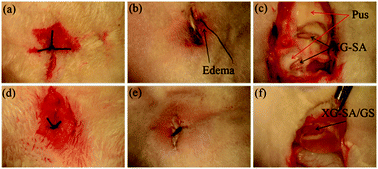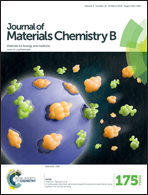In vitro and in vivo evaluation of xanthan gum–succinic anhydride hydrogels for the ionic strength-sensitive release of antibacterial agents
Abstract
In this work, we report a new approach to prepare high gel performance hydrogels which are used as ionic strength-sensitive drug release systems. Succinic anhydride (SA)-modified xanthan (XG–SA) derivatives were prepared and confirmed by Fourier transform-infrared spectroscopy and proton nuclear magnetic resonance spectroscopy. Rheological measurements showed that the storage moduli (G′) and loss moduli (G′′) of XG–SA were much higher than native XG suggesting a higher stability of the hydrogels. XG–SA could form stable hydrogels when the content of a dry gel was 1.4 wt%. Drug release studies showed the ionic strength-sensitive and sustained release of gentamicin (GS) for 9 days under aqueous physiological conditions. Biofilm inhibition assay revealed that the XG–SA/GS hydrogels were sufficient to inhibit biofilm formation. The Kirby-Bauer method showed that there was a zone of inhibition at around 8.2 mm indicating the excellent bactericidal function of the hydrogels. Cytocompatibility assessment against human lens epithelial cells revealed that the hydrogels supported cell adhesion, proliferation and migration when the loading dosage of GS was 1 mg g−1. XG–SA/GS hydrogels were compared to native XG–SA in the rabbit subcutaneous S. aureus infection model. XG–SA/GS hydrogels yielded a significantly lower degree of infection than XG–SA hydrogels at day 7. In this way, XG–SA hydrogels are promising drug delivery materials for antibacterial applications.


 Please wait while we load your content...
Please wait while we load your content...